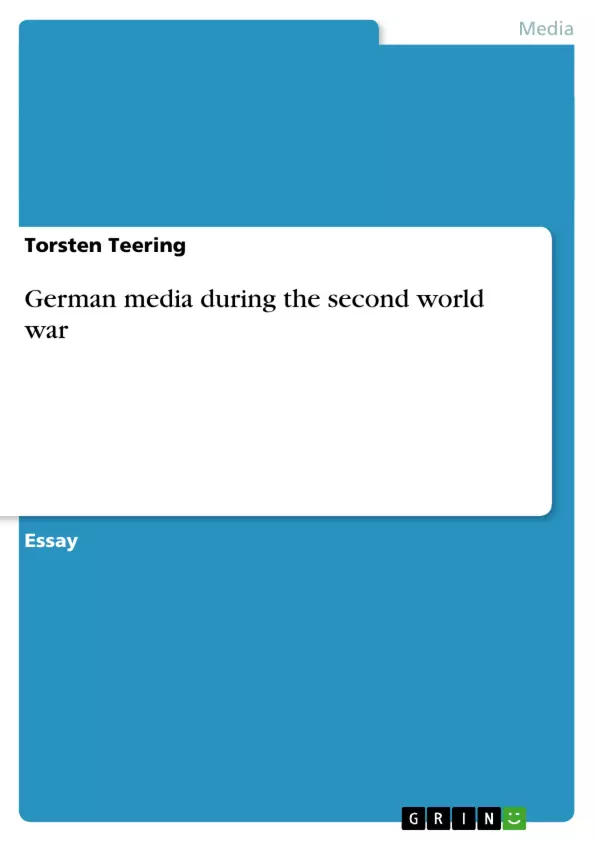During the Weimar Republic, the state often used the right to limit the press freedom by introducing new law. Even worse than this state control was the inner “cleaning” by industrials who sponsored newspapers and agencys. One of them was Hugenberg who published nationalistic parols and ideas. It is generally acknowledged that Hitler might not have been as popular without Hugenberg introducing national propaganda to the Germans (Meyn, 1990). Further, the Weimar Republic, which was the first German democracy, was despised by many people, which made them
susceptible to Fascism. In this time until he got into power 1933, Hitler gathered supporters against the inner enemy with the help of demagogy and propaganda (Klaeser, 1998).
Inhaltsverzeichnis (Table of Contents)
- Introduction
- The Weimar Republic
- The rise of Propaganda: 1933
- Radio
- Press
- The Press Agency
- Propaganda during the War
- Blitzkrieg
- The Russian Campaign
- Total War and the need for strenghtening morale
- The retreat into mythology and promises of retaliation
- The fall of Propaganda
Zielsetzung und Themenschwerpunkte (Objectives and Key Themes)
This essay explores the role of German media, primarily radio and the press, as tools of propaganda during the Second World War, analyzing how the National Socialists utilized these mediums from 1933 until the war's end.
- The restructuring of the German media landscape by the Nazi regime
- The use of propaganda during the war, including the Blitzkrieg, the Russian Campaign, and the need to bolster morale during the war's later stages
- The evolution of radio, the press, and press agencies after the war in the Allied Zones
- The influence of propaganda on public opinion and the creation of a national community
- The impact of the Nazi regime's control over the media on journalistic freedom and ethical considerations
Zusammenfassung der Kapitel (Chapter Summaries)
- Introduction: This chapter introduces the essay's focus on German media as a propaganda tool during the Second World War. It outlines the essay's structure, focusing on the media's restructuring by the state, its use as propaganda, and its post-war development in the Allied Zones.
- The Weimar Republic: This chapter examines the media landscape during the Weimar Republic, highlighting its susceptibility to fascist ideology due to state control and the influence of figures like Hugenberg. It describes the rise of Hitler's propaganda techniques in gathering support against the "inner enemy".
- The rise of Propaganda: 1933: This chapter details the establishment of the Ministry for Popular Enlightenment and Propaganda under Joseph Goebbels, emphasizing the control he gained over mass media. It describes Goebbels' vision for radio as a tool for shaping public opinion and his strategies to establish a unified, state-controlled radio system. The chapter also discusses Goebbels' early use of radio as a propaganda tool, exemplified by its role in the Saarland campaign.
- Radio: This chapter elaborates on the state regulation of radio during the Weimar Republic, emphasizing the control the Ministry of Post held over the medium. It discusses Goebbels' efforts to break down the federal structure of radio and create a unified, state-controlled system, culminating in the establishment of the Reich Radio Company. The chapter also examines the successful use of radio as a propaganda tool during the war, highlighting the production of cheap radios ("Volksempfänger") and the increasing reliance on light music to maintain audience interest.
- Press: This chapter explores the challenges Goebbels faced in controlling the press, given its association with parties, pressure groups, and private companies. It outlines his three-pronged approach: controlling individuals involved in the press industry, gaining ownership of the press through the Party's Eher Verlag, and controlling content through the state-controlled news agency. The chapter also describes the suppression of Communist and Social Democratic press, the increasing state ownership of newspapers, and the creation of a new generation of journalists aligned with party ideology. It concludes by emphasizing Goebbels' awareness of the need to maintain public interest and the creation of specialized Nazi campaigns for the press.
- The Press Agency: This chapter focuses on the merger of Germany's two main news agencies, Wolff's Telegraphisches Buero (WTB) and Hugenberg's Telegraphen Union, into the Deutsches Nachrichtenbuero. It discusses the state control over the merged agency and its dominance in providing news material for the German press.
- Propaganda during the War: Blitzkrieg: This chapter explores the initial success of Nazi propaganda during the Blitzkrieg, leveraging German military victories and fear-mongering tactics to undermine resistance in occupied countries. It emphasizes the use of news reels and documentaries to shape public opinion and the use of radio to spread propaganda throughout Europe.
- Propaganda during the War: The Russian Campaign: This chapter details the propaganda strategies employed during the Russian Campaign, focusing on the use of Bolshevism as a bogeyman and emphasizing the racial inferiority of the Soviet people. It explores the emotional press coverage of early victories, the shift to a campaign to bolster morale and distract from military setbacks, and the efforts to maintain public support despite the deteriorating situation.
Schlüsselwörter (Keywords)
The primary focus of this essay lies on the manipulation of German media by the National Socialist regime for propaganda purposes, specifically examining the role of radio and the press. Key themes explored include the transformation of the media landscape, the utilization of propaganda during the war, the impact of propaganda on public opinion, the control of journalistic freedom, and the post-war developments in the Allied Zones.
- Arbeit zitieren
- Torsten Teering (Autor:in), 2003, German media during the second world war, München, GRIN Verlag, https://www.grin.com/document/17382



